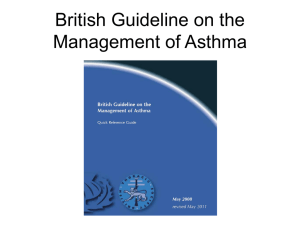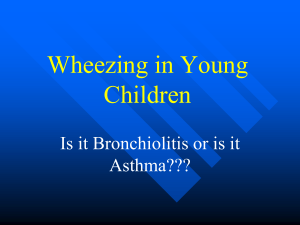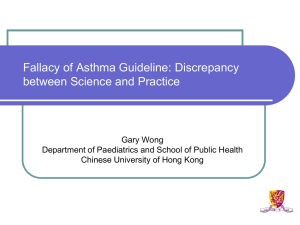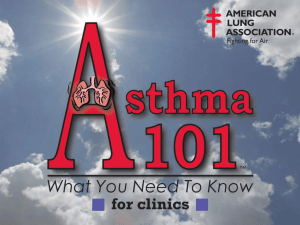What is Asthma?
advertisement
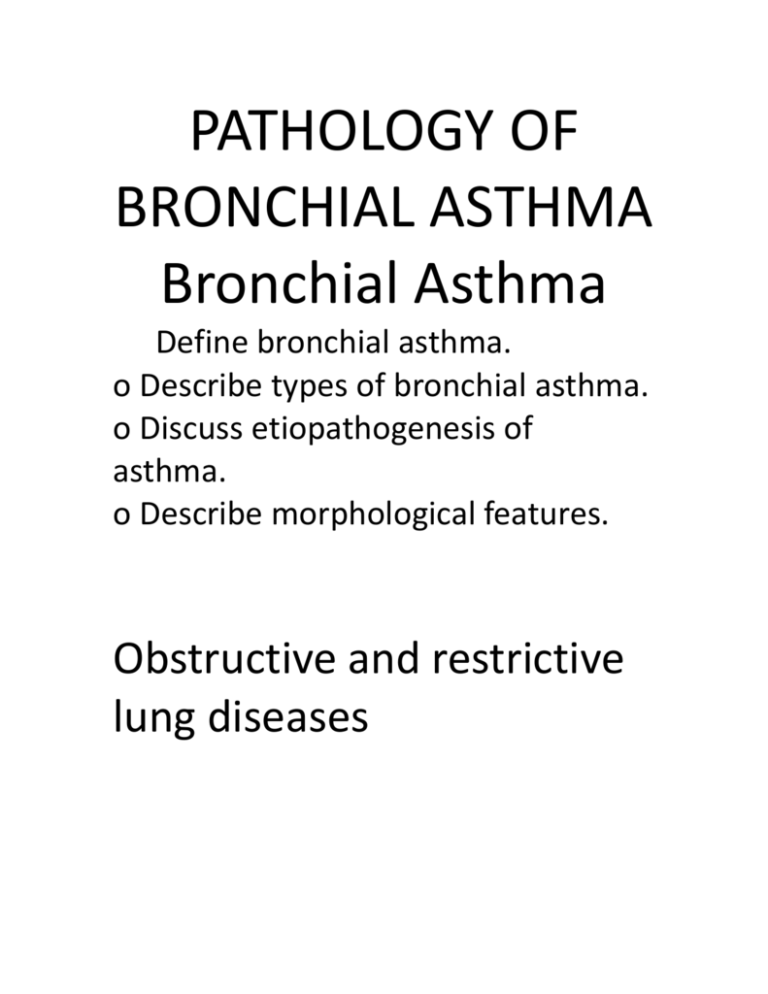
PATHOLOGY OF BRONCHIAL ASTHMA Bronchial Asthma Define bronchial asthma. o Describe types of bronchial asthma. o Discuss etiopathogenesis of asthma. o Describe morphological features. Obstructive and restrictive lung diseases • Obstructive lung diseases • (i.e. increased resistance to air flow) include:• 1. Bronchial Asthma. • 2. Emphysema. • 3. Chronic bronchitis. • 4. Bronchiectasis. • 5. Cystic fibrosis and bronchiolitis. • Why should we care about asthma? What is Asthma? • Definition: • Asthma is a chronic inflammatory disorder of the airways that causes recurrent spasmodic episodes, due to increased hyperirritability or responsiveness of the bronchial tree to various stimuli. • This associated with these clinical manifestations: • • • • 1. Wheezing. 2. Breathlessness. 3. Chest tightness. 4. Cough, particularly at night and/or in the early morning. It is manifested physiologically by a widespread narrowing of the air passages, which may be relieved spontaneously or as a result of therapy. Can not cure but can controlled. Life threatening disease How long this episodes taking Mild, severe) (Min\hr) Bronchial asthma risk factors place? ( •1- Atopy (allergic asthmalargest risk factorgenetic). •___________ ___________ _________ 2– Environmenta l factors( viruses, occupational exposures, allergens, cold air, dust, smoking ,others… ). ____________ ___________ ___________ __ 3- family history. _________________ ________________ ________________ ________________ ________________ _______________ 4others………… ….. Bronchial asthma Classifications Asthma may be categorized into types •___________ ___________ ___________ ___________ ____________ ___________ ___________ ___________ __ 3Bronchoco nstriction triggering agents include ( a) Seasonal asthma ( b) Exercise- induced asthma. (c) Druginduced asthma (e.g., aspirin & NSAID). (d) Occupational asthma (e) Eemotional asthma . (f ) Asthmatic bronchitis in smokers. ____________ ___________ ___________ _______ 4-Recent studies added three subphenotyp es of Asthma , based on Airway inflammation pattern . Asthma Types • 1- Atopic asthma (allergic sensitization, Extrinsic) : • Classic example of type I IgE-mediated hypersensitivity reaction. • Usually encountered in patient known case of rhinitis, eczema. • Genetic predisposition. • A positive family history of asthma is common. • Begins in childhood. • Triggered by environmental allergens, such as dusts, pollens, roach or animal dander, and certain types of foods., etc… • Diagnosis: clinical diagnosis is essential +…………………………… . • (a) Skin test : Using the offending antigen immediate whealand-flare reaction. • (b) Serum radioallergosorbent tests (called RAST): TO identify the presence of IgE specific for a panel of allergens. Asthma Types 2. Non-atopic asthma: - Non allergic. - Triggered commonly by Respiratory infection due to viruses (e.g., rhinovirus, parainfluenza virus). - Family history: less common. - Skin test: reveals negative reaction. - Mechanism: It is thought that virus-induced inflammation of the respiratory mucosa lowers the threshold of the subepithelial vagal receptors to irritants. Asthma Types 3- Bronchoconstriction triggering agents (a) Drug-Induced Asthma. - Aspirin-sensitive asthma + NSAID occurring with recurrent rhinitis and nasal polyps. -Others examples: adrenergic antagonists, coloring agents . Commonly occurs in adult. Mechanism: Aspirin inhibiting the cyclooxygenase pathway of arachidonic acid metabolism without affecting the lipoxygenase route, thus tipping the balance toward elaboration of the bronchoconstrictor leukotrienes. Asthma Types (b) Occupational Asthma . Caused or worsened by breathing in irritants on the job. • Triggered\stimulate d by: • 1) Fumes (epoxy resins, plastics) • 2) Metal and dusts (platinum, wood, cotton) • 3) Chemicals and Gases (formaldehyde, penicillin products, toluene, enzymes). • 4) Animal substances (5) Plants • - Minute quantities & Repeated exposure. • - Mechanisms: • According to stimulus include:• Type I hypersensitivity reactions . • Liberation of bronchoconstrictor substances. • Hypersensitivity responses of unknown origin. Bronchial asthma • 4- Pattern of the Airway inflammation : • 1) Eosinophilic asthma. • 2) Neutrophilic asthma. • 3) Mixed inflammatory asthma. • 4) Paucigranulocytic asthma. • These subgroups may differ in their: • (a) Etiology. • (b) Immunopathology. • (c ) Response to treatment. Asthma Pathogenesis-1 GENETIC CONSIDERATIONS Genetic predisposition In case of Atopic asthma- type I hypersensitivity Inheritance of susceptibility genes (postulation) that makes individuals prone to develop strong TH2 reactions against environmental antigens (allergens) Asthma Pathogenesis-2 1. The airway epithelium and submucosa contain dendritic cells that capture &process antigen \allergens. Initial sensitization stimulate induction of TH2 cells. 2. TH2 cells secrete cytokines e.g.(IL-4, IL-5,IL-13) that promote allergic inflammation and stimulate B cells to produce IgE and other antibodies. 3. Action of Cytokins (a) IL-4 Production of IgE by B cells. (b)IL-5 Activates recruited eosinophils. (c ) IL-13 Mucus secretion(bronchial submucosal glands) also Promotes IgE production by B cells. Asthma Pathogenesis-3 (Early & Late reaction) 3. IgE coats submucosal mast cells. 4. Repeat exposure triggers the mast cells to release granule contents and produce cytokines and other mediators induce the early-phase (immediate hypersensitivity) reaction and the late-phase reaction Asthma Pathogenesis-4 (Early reaction- Minutes) - AntigensTh2 IgE productionIgE binding to mast cells leads to Eosp. recruitment& release of primary mediators= (Histamine, chemotactic factors, and secondary mediators i.e. leukotriens, prostaglandins, cytokines and neuropeptides). This results in: (A) Bronchospasm- triggered by direct stimulation of subepithelial vagal (parasympathetic) receptors through both central and local reflexes . (B) Secretion of mucus. (C) Variable degree of vasodilatation& increase permeability. (D) Accumulation of leukocytes. Asthma Pathogenesis-5 (Late reaction- Hours) - 6- 10 hr later, produces a continued state of airway hyperresponsiveness with eosinophilic and neutrophilic infiltration. (steroid helpful to treat this stage) Components: consists largely of inflammation with recruitment of leukocytes= ( Eosinophils, neutrophils, and more T cells). - Leukocyte recruitment is stimulated by chemokines produced by mast cells, Epithelial cells (eotaxin ) and T cells, and by other cytokines. - Outcome: persistent bronchospasm, edema, and necrosis of epithelial cells by The major basic protein of eosinophils. Cellular sources of inflammatory mediators& their effects Morphology of Asthma - Airway remodeling. •Overall thickening of airway wall . Reduction of diameter •Basement membrane fibrosis(BM thickening). •Increases muscle mass (Hypertrophy and/or hyperplasia). •Increased in size and number of blood vessels. •Increase number of the submucosal glands. • Mucus metaplasia of epithelium. •Increased fibrogenic factors collagen type I,II “scar” •Irreversible Airflow obstruction. Bronchial asthma, microscopic Curschman’s spirals Charcot-Leyden crystals THE END


